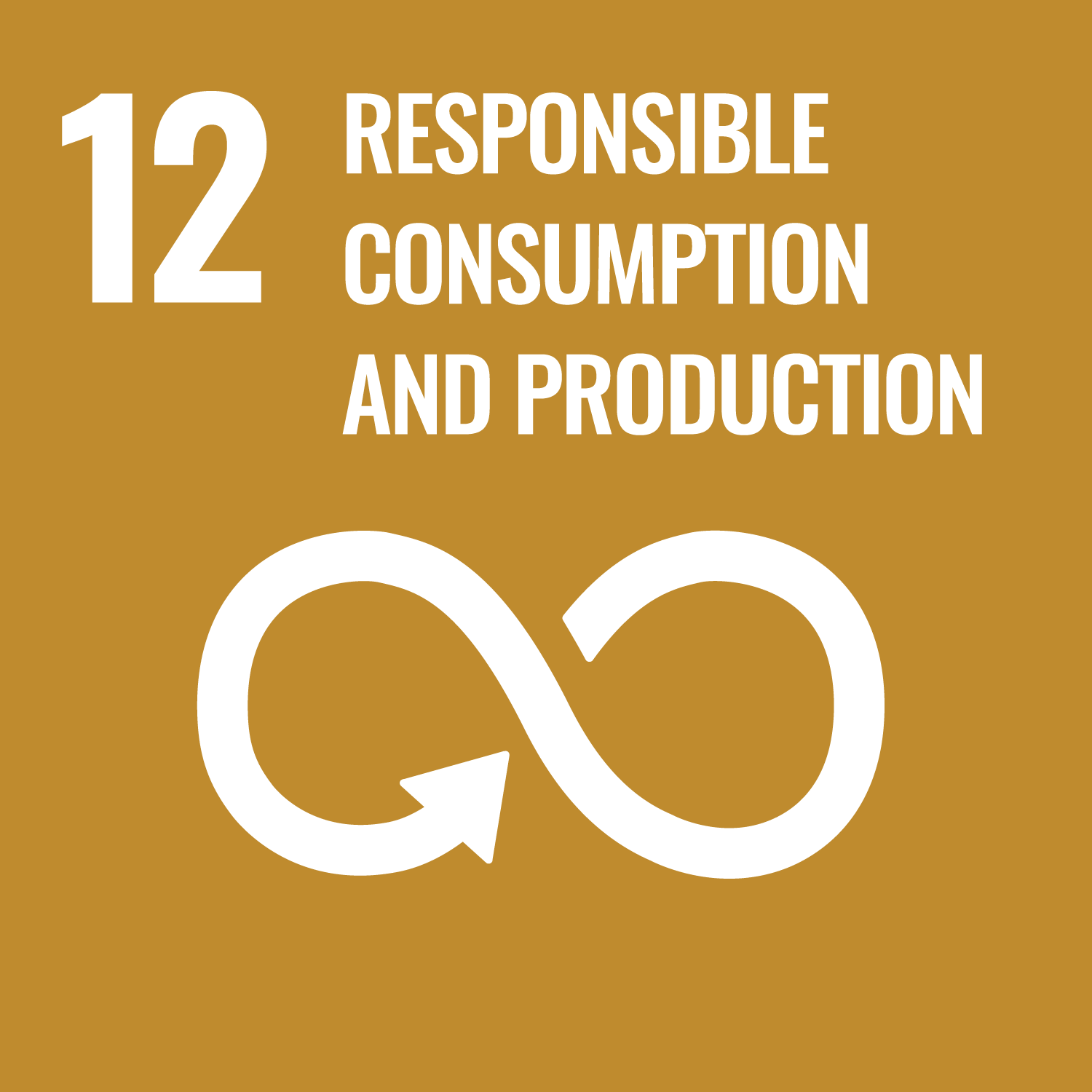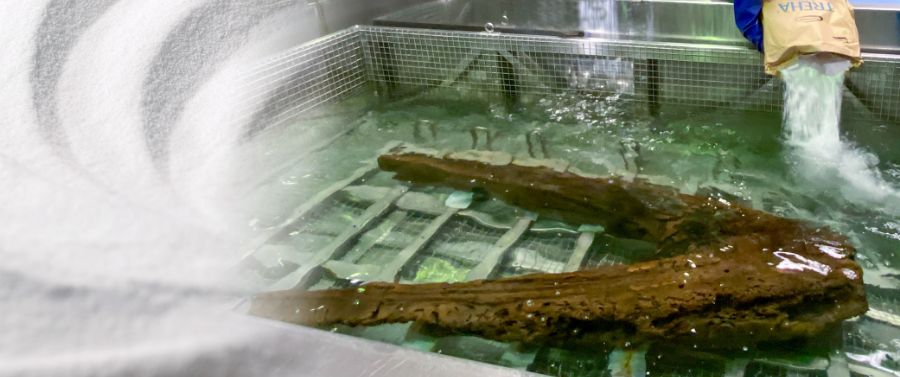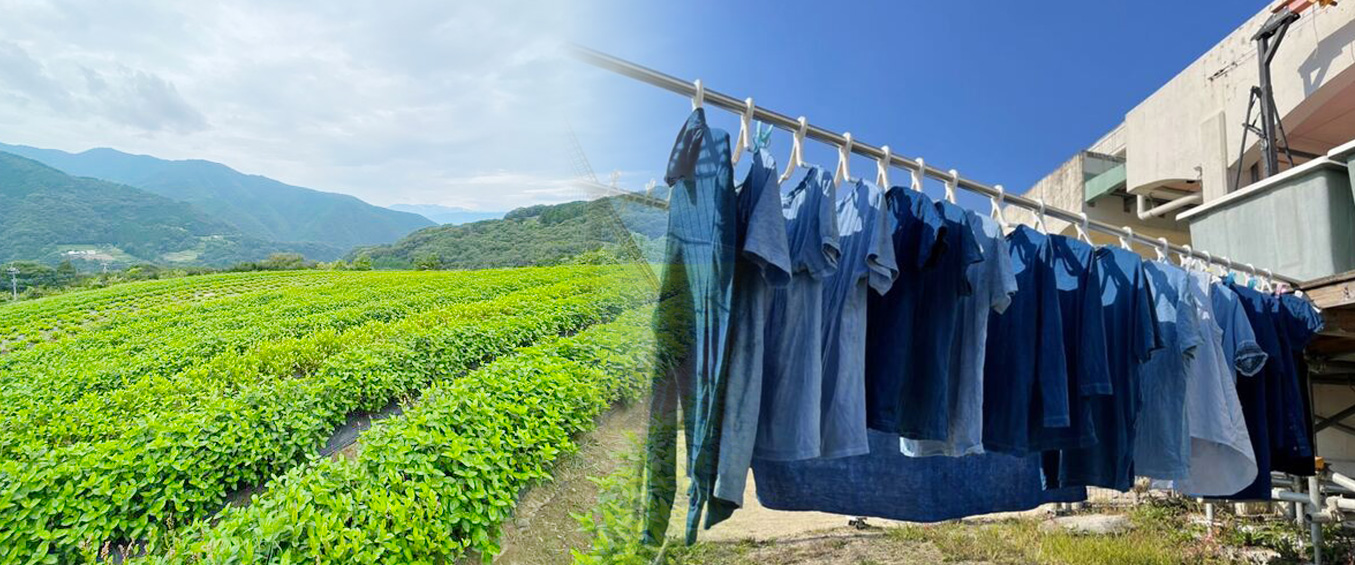
Sustainable Stories
Nagase Viita's WEB Magazine
03Story
March 30, 2022
Pioneering the Way to Making Sustainable Agriculture a Reality:Biostimulants Offering New Solutions
You may have heard the term “bio-stimulant” – a new keyword in the field of agriculture. Although still unfamiliar to the general public, biostimulants are being used to increase productivity by supplementing the effects of fertilizers and agrochemicals. They are now gaining attention in countries around the world as a new technology that is helping to solve various agricultural, food supply and procurement-related issues. In Japan, an industry association was established in 2018, and initiatives for the popularization of biostimulants have begun.
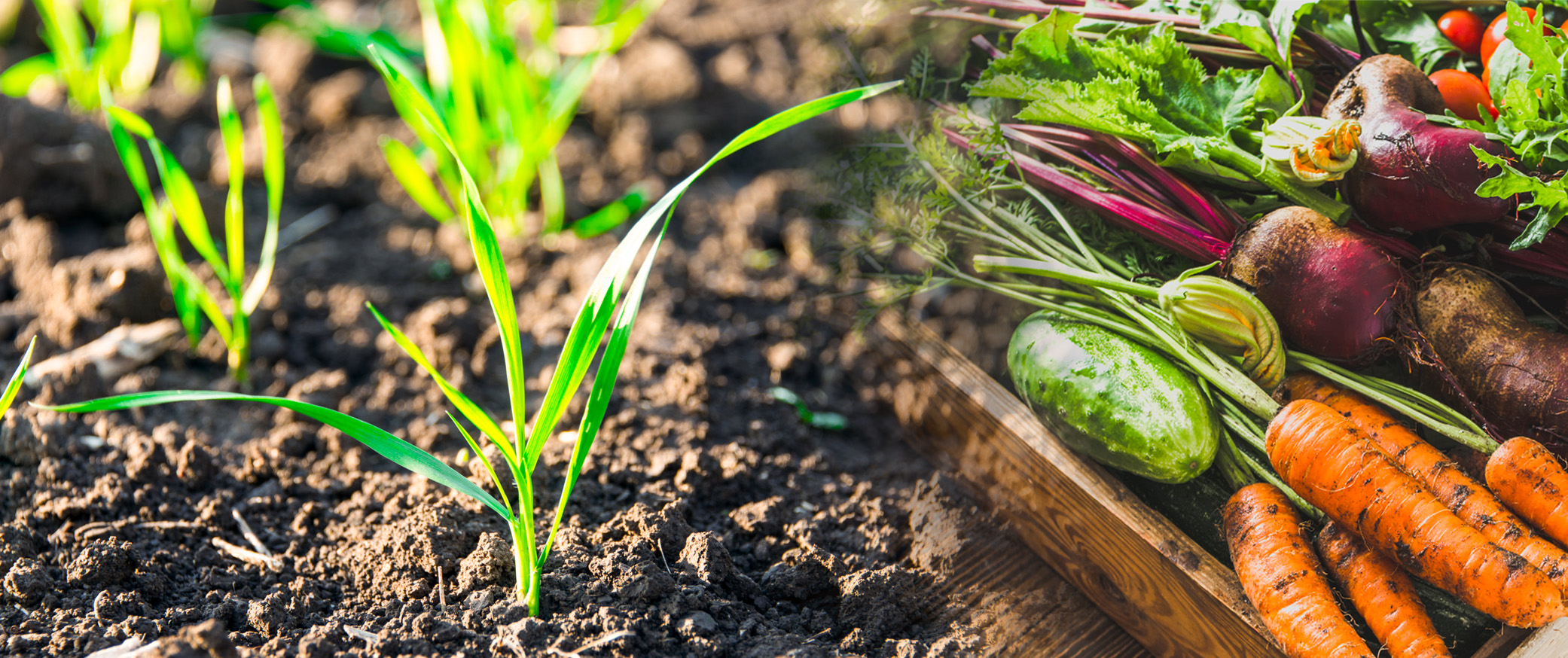
New Technologies for Solving Food Supply Issues
Modern agriculture is facing various problems such as explosive growth of the global population, climate change, large-scale natural disasters, and the spread of infectious diseases. Japan has suffered labor shortages due to population aging. Now there is an urgent need to build sustainable food production systems for the future, more productive and environmentally friendly agricultural technologies are required than ever before.
New agricultural materials called biostimulants have been in the spotlight in recent years.
Biostimulants differ from substances such as fertilizers, which supply nourishment to plants, and agrochemicals, which exterminate pests and weeds. They have the potential to bring out the original, natural power of plants, which will lead to steady growth and harvests.
Europe has been an early leader in this field. However, interest in Japan has been growing rapidly and the use of biostimulants as an innovative agricultural technology is expanding under the Green Food System Strategy formulated by the Ministry of Agriculture, Forestry and Fisheries (MAFF) in 2021.
New agricultural materials called biostimulants have been in the spotlight in recent years.
Biostimulants differ from substances such as fertilizers, which supply nourishment to plants, and agrochemicals, which exterminate pests and weeds. They have the potential to bring out the original, natural power of plants, which will lead to steady growth and harvests.
Europe has been an early leader in this field. However, interest in Japan has been growing rapidly and the use of biostimulants as an innovative agricultural technology is expanding under the Green Food System Strategy formulated by the Ministry of Agriculture, Forestry and Fisheries (MAFF) in 2021.
Increasing Stress Resistance and Drawing Out the Potential of Plants
 ▲Osamu Sudo (secretary-general of Japan Biostimulant Association)
▲Osamu Sudo (secretary-general of Japan Biostimulant Association)
 ▲Osamu Sudo (secretary-general of Japan Biostimulant Association)
▲Osamu Sudo (secretary-general of Japan Biostimulant Association)
- What is meant by “drawing out the potential of plants”?
“The maximum volume of crops that can be harvested is determined genetically when they are still seeds. However, by being exposed to a lot of stress while growing from seeds, this amount is reduced to a maximum of around 80% of the original yield potential statistically.One means of bridging this gap is to use agrochemicals, which reduce exposure to biological stresses such as pests and weeds. In addition to this, biostimulants control abiotic stresses such as high and low temperatures and soil salinity, which cannot be managed by agrochemicals.”
 ▲A model for crop yields
▲A model for crop yields
The raw materials for biostimulants are naturally derived substances. They include humic acids produced by the decomposition of plants, polysaccharides extracted from seaweed, amino acids and minerals, and microorganisms that coexist with plants. Some of them have been used in agriculture since ancient times. In a broader sense, the Japanese-originated bokashi compost (a fertilizer made from fermented organic matter) can be considered one form of bio-stimulant.
Deploying these materials effectively in crop cultivation will produce superior effects; for instance, improving the photosynthetic function and increasing root activity in plants, such as increasing the absorption power of water and nutrients. They also increase resistance to stress.
Deploying these materials effectively in crop cultivation will produce superior effects; for instance, improving the photosynthetic function and increasing root activity in plants, such as increasing the absorption power of water and nutrients. They also increase resistance to stress.
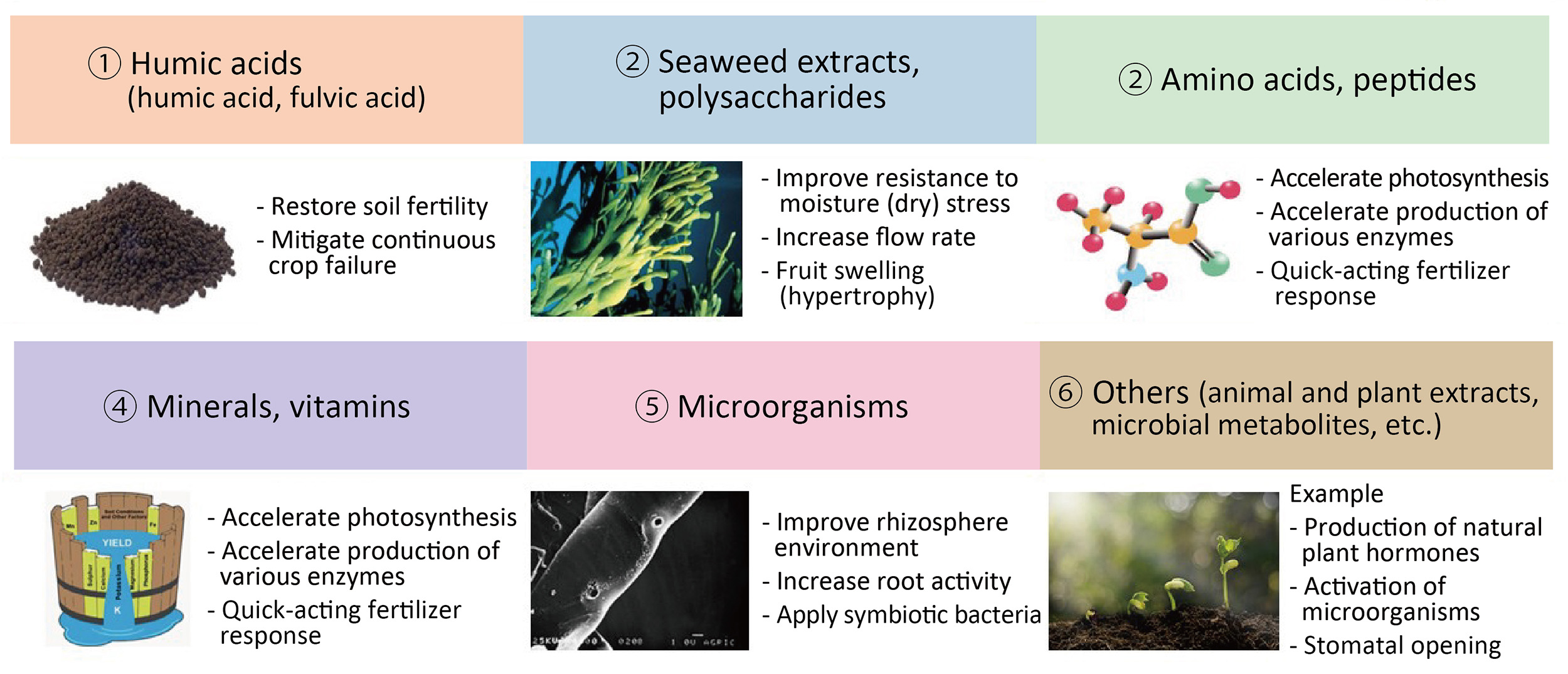 ▲Example bio-stimulant classifications
▲Example bio-stimulant classifications
“What I would like to emphasize here is that biostimulants are not a kind of trump card that can be used in all cases. By combining them with complementary existing technologies such as agrochemicals, fertilizers, soil improvers and plant breeding, we aim to achieve better growth while distributing risks,” Mr. Sudo explains.
Mr. Sudo continues.
“In Japan, which has a declining population, the background is somewhat different from the international situation. The advantages of biostimulants in Japan are focused more on improving quality rather than increasing crop yields. High-quality, good-tasting crops can meet the needs of consumers.
If crops grow in a good state, the shape and size of plants in the crop will become more uniform, and the number of plants that are considered substandard (i.e., failing to meet specifications) will decrease. Another advantage is in reducing waste loss. We believe that by reducing the amount of labor required for sorting, we can contribute to improving production efficiency for farmers who are struggling with labor shortages.”
Another factor in the interest in biostimulants is that they are naturally derived. Biostimulants can limit excessive use of agrochemicals and chemical fertilizers by supplementing the roles of these substances without placing a burden on the environment, so they are highly likely to satisfy the needs of agriculture in the future.
- Why is there growing global interest in biostimulants now?
“With limited arable land and rapidly increasing populations, the only way to procure sufficient agricultural production worldwide is to increase crop yields per unit area. The key to improving efficiency is in finding ways to combat abiotic stresses, which is still a relatively untouched issue. We believe that by combining conventional solutions such as fertilizers and agrochemicals with new environmentally friendly technologies like biostimulants, we will be able to tackle the food supply problems of the future.”Mr. Sudo continues.
“In Japan, which has a declining population, the background is somewhat different from the international situation. The advantages of biostimulants in Japan are focused more on improving quality rather than increasing crop yields. High-quality, good-tasting crops can meet the needs of consumers.
If crops grow in a good state, the shape and size of plants in the crop will become more uniform, and the number of plants that are considered substandard (i.e., failing to meet specifications) will decrease. Another advantage is in reducing waste loss. We believe that by reducing the amount of labor required for sorting, we can contribute to improving production efficiency for farmers who are struggling with labor shortages.”
Another factor in the interest in biostimulants is that they are naturally derived. Biostimulants can limit excessive use of agrochemicals and chemical fertilizers by supplementing the roles of these substances without placing a burden on the environment, so they are highly likely to satisfy the needs of agriculture in the future.
 ▲Solving agricultural issues with both conventional and new solutions utilizing biostimulants
▲Solving agricultural issues with both conventional and new solutions utilizing biostimulants
Trehalose as a Bio-Stimulant
Nagase Viita has been conducting research into biostimulants for many years.
“Previous research has shown that our trehalose has the ability to induce the original immunity of plants.
For example, it has been reported that giving trehalose to plants can induce hormones that regulate the opening and closing of pores, causing a phenomenon in which the plants’ ability to withstand dryness is increased. Spraying with trehalose also synthesizes starch, which is disliked by pests such as aphids. Various benefits have been observed, such as in avoiding crop damage from aphids without the use of pesticides.”
Dr. Takanobu Higashiyama, who is involved in bio-stimulant-related research at Nagase Viita, explains.
“Previous research has shown that our trehalose has the ability to induce the original immunity of plants.
For example, it has been reported that giving trehalose to plants can induce hormones that regulate the opening and closing of pores, causing a phenomenon in which the plants’ ability to withstand dryness is increased. Spraying with trehalose also synthesizes starch, which is disliked by pests such as aphids. Various benefits have been observed, such as in avoiding crop damage from aphids without the use of pesticides.”
Dr. Takanobu Higashiyama, who is involved in bio-stimulant-related research at Nagase Viita, explains.
 ▲Trehalose powder and crystals
▲Trehalose powder and crystals
“Trehalose is originally a component that exists in bacteria and the bodies of insects, so spaying trehalose will trigger a response in plants as if these stressors are present. The plants produce hormones to resist stress. This action makes them less susceptible to disease. Put simply, it’s like vaccination. In addition to abiotic environmental stresses, we also expect to apply this method to increase resistance to biological stresses such as pests and diseases in the future,” explains Dr. Higashiyama.
There are cases of indirect use of trehalose for its cell stabilizing function in biostimulants.
“In South America, microorganisms called rhizobia are used as biostimulants formulations for soybean cultivation. Since the rhizobium preparation is a live fungus, it cannot be stored at room temperature for an extended period as it is. By adding trehalose, we have been able to stabilize the membrane structure of the fungus and greatly improve its shelf life, gaining widespread use among soybean farmers in South America.”
There are cases of indirect use of trehalose for its cell stabilizing function in biostimulants.
“In South America, microorganisms called rhizobia are used as biostimulants formulations for soybean cultivation. Since the rhizobium preparation is a live fungus, it cannot be stored at room temperature for an extended period as it is. By adding trehalose, we have been able to stabilize the membrane structure of the fungus and greatly improve its shelf life, gaining widespread use among soybean farmers in South America.”
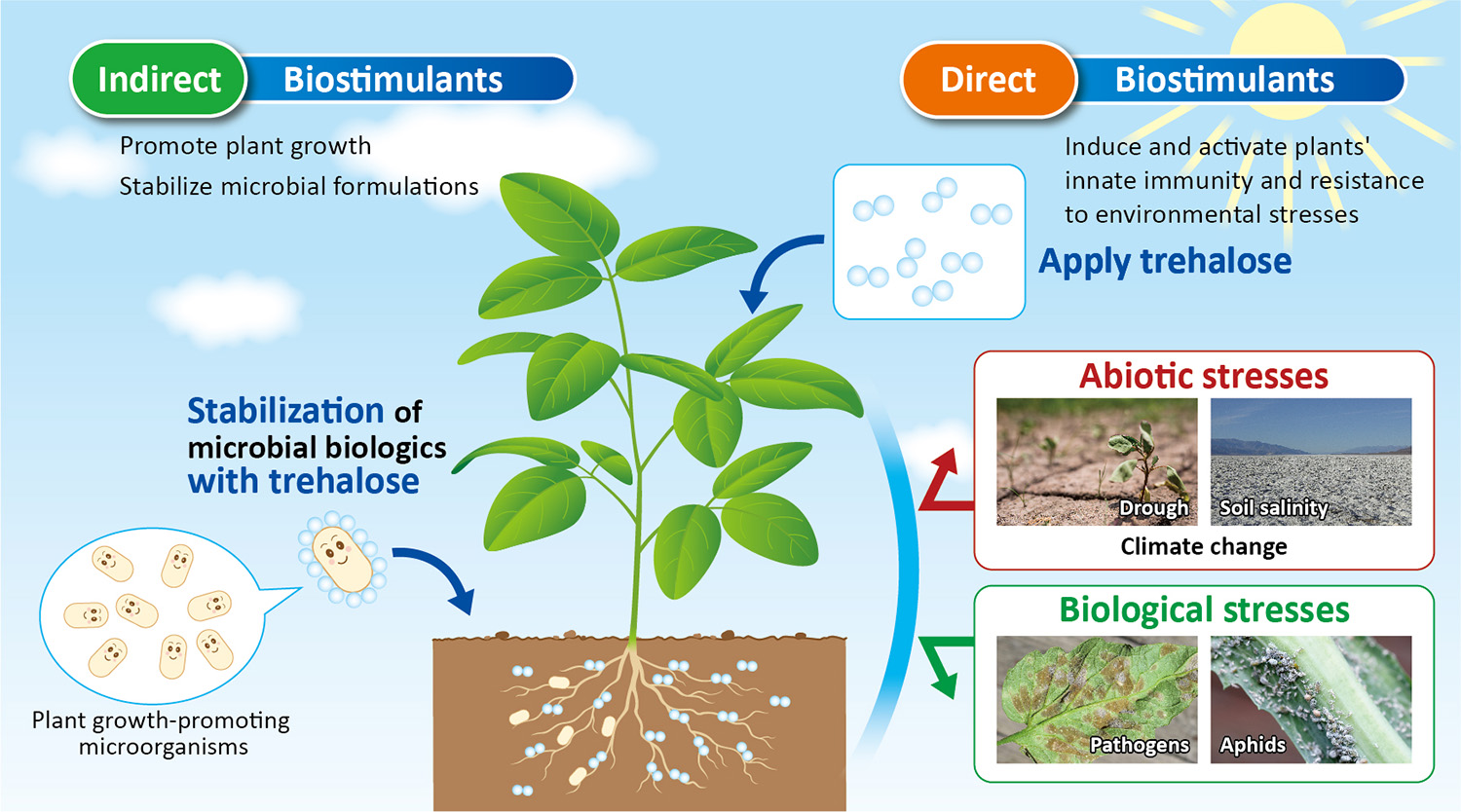 ▲Trehalose has a direct effect as a bio-stimulant and an indirect effect as a stabilizer for other biostimulants
▲Trehalose has a direct effect as a bio-stimulant and an indirect effect as a stabilizer for other biostimulants
“The widespread adoption of rhizobium preparations has major benefits for local farmers.
The first advantage is cost. If rhizobia cannot be used, then nitrogen must be supplemented using large amounts of expensive chemical fertilizers. Because rhizobia preparations, which efficiently fix nitrogen from the atmosphere, are extremely cheap by comparison, they improve the economic situation of farmers.
Another advantage is safety. Because biostimulants are of natural origin, they can solve problems such as the decline in soil fertility due to the continuous use of chemical fertilizers, and health hazards to farmers.
Dr. Higashiyama continues, “Trehalose is originally made using microorganisms in the soil, so their use in agriculture is essentially returning something that we got from the soil to the soil again. In a sense, we could say that it is the most natural use of trehalose.
We feel that there is great potential in applying trehalose’s excellent quality retention capabilities to the production of crops, upstream of food processing, which will resolve agricultural problems around the world.”
The first advantage is cost. If rhizobia cannot be used, then nitrogen must be supplemented using large amounts of expensive chemical fertilizers. Because rhizobia preparations, which efficiently fix nitrogen from the atmosphere, are extremely cheap by comparison, they improve the economic situation of farmers.
Another advantage is safety. Because biostimulants are of natural origin, they can solve problems such as the decline in soil fertility due to the continuous use of chemical fertilizers, and health hazards to farmers.
Dr. Higashiyama continues, “Trehalose is originally made using microorganisms in the soil, so their use in agriculture is essentially returning something that we got from the soil to the soil again. In a sense, we could say that it is the most natural use of trehalose.
We feel that there is great potential in applying trehalose’s excellent quality retention capabilities to the production of crops, upstream of food processing, which will resolve agricultural problems around the world.”
Further Research and Legislative Reform for Promoting the Use
As seen here, there are high expectations for biostimulants. Nonetheless, a broad range of bio-stimulant materials and applications exist, and their effects still have many aspects that have yet to be explained. As Mr. Sudo makes clear, a number of obstacles remain before they achieve widespread use in Japan.
“To put it another way, natural action is gentle action, and the way these effects manifest themselves varies greatly depending on interactions with various other growth conditions. There are many uncertainties, so it is natural for farmers to feel that it is a difficult area to invest money and effort into,” he says.
“If we are to promote the use, we will need quantitative evidence of the usefulness of biostimulants. This will require a concerted effort involving industry, government and academia. At the same time, we will need to encourage understanding of their unique character. As a prerequisite, there is also a pressing need for us to discuss quality standards for biostimulants in the industry and exchange opinions with the government. The association is prioritizing these activities.”
In the future, agriculture will need to reduce its reliance on chemical pesticides and fertilizers, and biostimulants will play a vital role in this.
When farmers can start making effective use of biostimulants with peace of mind, that will represent a major step towards sustainable agriculture. At Nagase Viita, we’ll be stepping up our focus on R&D, aiming to make a significant contribution to this field through products and technologies such as trehalose.
“To put it another way, natural action is gentle action, and the way these effects manifest themselves varies greatly depending on interactions with various other growth conditions. There are many uncertainties, so it is natural for farmers to feel that it is a difficult area to invest money and effort into,” he says.
“If we are to promote the use, we will need quantitative evidence of the usefulness of biostimulants. This will require a concerted effort involving industry, government and academia. At the same time, we will need to encourage understanding of their unique character. As a prerequisite, there is also a pressing need for us to discuss quality standards for biostimulants in the industry and exchange opinions with the government. The association is prioritizing these activities.”
In the future, agriculture will need to reduce its reliance on chemical pesticides and fertilizers, and biostimulants will play a vital role in this.
When farmers can start making effective use of biostimulants with peace of mind, that will represent a major step towards sustainable agriculture. At Nagase Viita, we’ll be stepping up our focus on R&D, aiming to make a significant contribution to this field through products and technologies such as trehalose.
- ■Japan Biostimulant Association website (Japaese):https://www.japanbsa.com/
 JAPAN BIOSTIMULANT ASSOCIATION
JAPAN BIOSTIMULANT ASSOCIATION
- Nagase Viita’s Sustainability Focus Points: Biostimulants
- ●Increase resistance to abiotic stresses (high-temperature damage, soil salinity, cold damage, etc.) which occur frequently due to abnormal weather in recent years, and improve yield and quality of crops by drawing out the innate power of plants
- ●Restore soil fertility and contribute to the realization of sustainable agriculture by suppressing excessive use of chemical pesticides and fertilizers
- ●Protect farmers from health hazards by suppressing excessive use of agrochemicals
- ●Improve labor efficiency in sorting by improving the quality of agricultural produce, thereby contributing to the reduction of workloads for farmers and reducing waste loss


